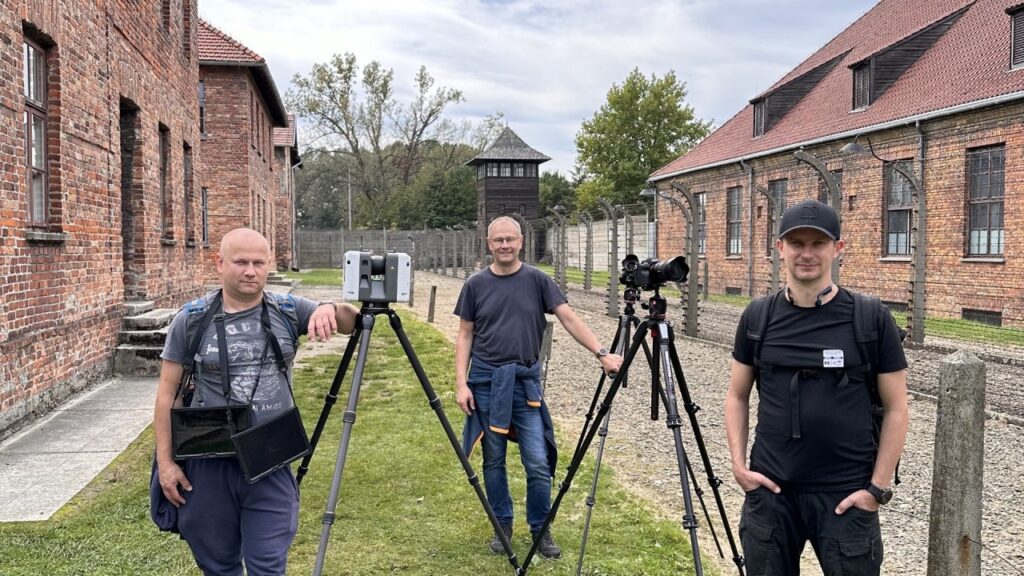Filming at Auschwitz-Birkenau has been restricted for four decades out of respect for its history and the victims it commemorates and few other reasons. Yet demand for authentic, impactful films continues to grow, and the urgency to safeguard truth has never been greater, as survivors pass away and misinformation rises.
In 2025, filmmaker Maciej Żemojcin, with support from the Auschwitz-Birkenau Foundation and Memorial, led the creation of Picture from Auschwitz, the first certified digital replica of German Nazi Auschwitz Camp. Using advanced scanning by Robert Kraczek, the team captured the camp in unprecedented detail. The additional process was Volinga’s 3D Gaussian Splatting (3DGS) pipeline with support of Andrii Schramko.

“Filming within a virtual version of Auschwitz allows filmmakers of all types to tell its harrowing story, ensuring the 100% authenticity of the site,” explained Żemojcin.
The project debuted at Cannes Marché du Film 2025, supported by honorary ambassadors Agnieszka Holland, film director, and Ryszard Horowitz, Auschwitz survivor and world-renowned photographer. Licensed exclusively through the Auschwitz-Birkenau Foundation, the Virtual Film Location enables filmmakers and educators to tell stories rooted in authenticity, while proceeds directly fund the preservation of the Memorial.
“I am not afraid of new technologies in cinema. I think the possibilities to tell those stories again are endless”, said Holland
The Auschwitz-Birkenau Memorial is one of the most important historical sites in the world, a place of solemn remembrance and warning. Out of respect, feature film productions have never been permitted to shoot on the grounds. Even Steven Spielberg, when creating Schindler’s List, was denied permission to shoot directly on the terrain of the Auschwitz Memorial and had to build a replica instead. Interest in films about Auschwitz continues to grow, reflecting the public’s need to engage with this history. Nearly 80 years after liberation of the camp, the number of living survivors is dwindling. With misinformation and denial on the rise, preserving the forensic truth of the site has become critically important. The challenge was clear: how could filmmakers be granted access to Auschwitz for storytelling without disturbing the Memorial itself?
To address this, Żemojcin and his team, in partnership with the Auschwitz-Birkenau Foundation and leading technical experts, created a fully certified digital twin of Auschwitz. An additional part of the process was Volinga’s 3DGS pipeline, which enabled the team to capture and reconstruct the site with speed, and photorealism. Integrated with Unreal Engine, the technology achieved a level of immediacy and realism that is more visually convincing for the broader audience compared to regular photogrammetry. Every detail, from the “Arbeit Macht Frei” gate to courtyard cobblestones, was meticulously captured and documented. The Auschwitz Memorial oversaw the process to ensure accuracy and ethical use, and all scripts undergo historical review, with licensing proceeds funding ongoing preservation efforts.
“Everything that remains of the camp must be preserved for future generations,” said Horowitz. “This new technology makes it easier to tell stories rooted in authenticity.”
By completing a digital replica of Auschwitz, the team created a permanent digital archive that preserves the site for future generations. By offering filmmakers and educators access to an authentic, photorealistic environment, the project empowers storytelling that is emotionally resonant and historically accurate. Licensing revenue directly supports the Memorial’s mission of remembrance, education, and combating hatred, while the initiative sets a new industry standard, demonstrating how technology providers and cultural institutions can collaborate ethically to safeguard memory.
“Such projects should play a vital role in raising awareness and deepening emotional engagement with the history of Auschwitz and the Shoah,” said Dr. Piotr Cywiński, Director, Auschwitz Museum.

Picture from Auschwitz is more than a technical achievement, it is a moral imperative. By combining technology including Volinga’s 3DGS pipeline with the guidance of historians, survivors, the project has set a new gold standard for how technology can protect memory, truth, and human dignity.
“By digitising the site of the Memorial, we ensure that its history will not fade with time,” said Wojciech Soczewica, Director General, Auschwitz-Birkenau Foundation. “This project is a powerful example of how culture and technology can unite to protect our shared human history.”
As Żemojcin notes: “People value authenticity. And that’s what this project aims to protect, not just through accuracy, but through accessibility, emotional resonance, and ethical integrity.”
Learn more about the project or request access to the Virtual Film Location: film.auschwitz.org
Curious how Volinga can support your heritage, cinematic, or educational project?
Credits:
Project Team:
Bartosz Bartyzel, Maciej Żemojcin, Wojciech Soczewica, Kristen Davis, Paweł Sawicki.
Project Honorary Ambassadors:
Agnieszka Holland, Ryszard Horowitz
3D Scanning Specialists:
Robert Kraczek, Jacek Kraczek, with additional support of Andrii Shramko
Technology Partners:
ATM Virtual, Leica Geosystems, Volinga
Institutional Partners:
Auschwitz-Birkenau Memorial, Auschwitz-Birkenau Foundation